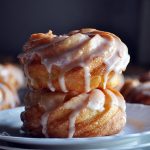 In 1809, American author Washington Irving published a book called A History of New York, ostensibly written by one Diedrich Knickerbocker, an imaginary Dutch immigrant. Nine years later, in 1818, Irving introduced the word cruller to the English language when he briefly mentioned the curly pastry in his Legend of Sleepy Hollow. That Irving both invented the name Knickerbocker and introduced the word cruller is a strange coincidence: he could not have known, when he created his Diedrich Knickerbocker persona, that forty years later knickerbocker would become the ethnic nickname for Dutch immigrants, the same Dutch immigrants who introduced the cruller pastry to North America (later still, Irving’s knickerbocker was adopted as the name of the knee-length shorts often worn by Dutch men). Of course, not only is the cruller Dutch in origin, its name is too: the Dutch crullen, meaning to curl, is the source of the name of the pastry because it is twisted and curled before it is fried in oil. However, this was not the first time that English had borrowed the Dutch word crullen: in the fourteenth century, the adjective form of the word, crul, was adopted by English to describe hair curled into ringlets. For more than a hundred years, crul remained the usual spelling and pronunciation of this word until, in the sixteenth century, the middle vowel and consonant traded places—a process known as metathesis—thus establishing the word curl. Accordingly, the curlers you put in your hair, and the crullers you put in your mouth, are actually one and the same word.
In 1809, American author Washington Irving published a book called A History of New York, ostensibly written by one Diedrich Knickerbocker, an imaginary Dutch immigrant. Nine years later, in 1818, Irving introduced the word cruller to the English language when he briefly mentioned the curly pastry in his Legend of Sleepy Hollow. That Irving both invented the name Knickerbocker and introduced the word cruller is a strange coincidence: he could not have known, when he created his Diedrich Knickerbocker persona, that forty years later knickerbocker would become the ethnic nickname for Dutch immigrants, the same Dutch immigrants who introduced the cruller pastry to North America (later still, Irving’s knickerbocker was adopted as the name of the knee-length shorts often worn by Dutch men). Of course, not only is the cruller Dutch in origin, its name is too: the Dutch crullen, meaning to curl, is the source of the name of the pastry because it is twisted and curled before it is fried in oil. However, this was not the first time that English had borrowed the Dutch word crullen: in the fourteenth century, the adjective form of the word, crul, was adopted by English to describe hair curled into ringlets. For more than a hundred years, crul remained the usual spelling and pronunciation of this word until, in the sixteenth century, the middle vowel and consonant traded places—a process known as metathesis—thus establishing the word curl. Accordingly, the curlers you put in your hair, and the crullers you put in your mouth, are actually one and the same word.
A sugary pastry, typically composed of strips of dough, where a pair of those are intertwined and submerged into boiling oil for deep frying.
A pastry typically consumed for breakfast, crafted using baking powder dough and fried in fat; crullers bear a strong resemblance to doughnuts, albeit with a different form factor, as they are molded into strips and twisted before being cooked.
